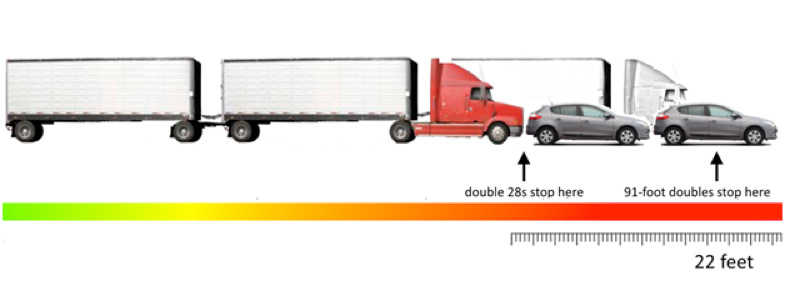Law enforcement leaders and other safety advocates oppose longer and heavier trucks because they would endanger motorists.
Many law enforcement leaders across the country are strongly opposed to truck size and weight increases. National law enforcement organizations have voiced their firm opposition to these bigger trucks, including:
- National Sheriffs’ Association
- National Troopers Coalition
- International Association of Chiefs of Police
- National Association of Police Organizations
Stopping Distances
First and foremost, law enforcement leaders are concerned that longer trucks would endanger motorists as well as increase the risks to law enforcement officers on roadsides. This view is confirmed by the U.S. Department of Transportation (USDOT) Final Report to Congress published in 2016 that found Double 33s take 252 feet to stop—that is 22 feet longer than twin-trailer trucks on the road today.

USDOT also found in its two-year study that 97,000-pound, six-axle trucks take 247 feet to stop—that is 12 feet longer than today’s 80,000-pound, five-axle trucks.
Crash Rates
Another critical safety factor law enforcement groups point to his higher crash rates for bigger trucks. USDOT found in its previous study that multi-trailer trucks have an 11 percent higher fatal crash rate than single-trailer trucks.
USDOT’s most recent study found that heavier trucks with six axles—both 91,000-pound and 97,000-pound configurations—have higher crash rates in limited state testing:
- Idaho – 99 percent higher crash rates for six-axle trucks up to 97,000 pounds
- Michigan – 400 percent higher crash rates for six-axle trucks up to 97,000 pounds
- Washington – 47 percent higher crash rates for six-axle trucks up to 91,000 pounds
Out-of-Service Violations
Also a concern of law enforcement, USDOT found that twin-trailer configurations had the highest out-of-service violation rates compared to tractor semitrailer and triple-trailer trucks. Law enforcement leaders consider out-of-service violations to be a key indicator of truck safety. Further, twin-trailer configurations had out-of-service violation rates that were 58 percent higher than single-trailer trucks.
Regarding heavier trucks, USDOT found both higher out-of-service and braking violations:
- Trucks weighing over 80,000 pounds had higher overall out-of-service (OOS) rates compared to those at or below 80,000 pounds.
- Trucks weighing over 80,000 pounds had brake violation rates that were 18 percent higher compared to those at or below 80,000 pounds.
Read the National Sheriffs’ Association comments on bigger trucks to USDOT here: https://www.regulations.gov/document?D=FHWA-2014-0035-0064
